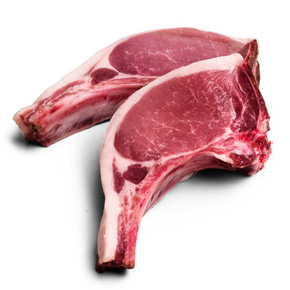If you are eating leftover pork chops that have not been cooked well-done, you’re putting yourself at risk for Salmonella and Listeria exposure. While many individuals prefer to consume their pork medium, a new study published in Risk Analysis: An International Journal revealed that cooking pork chops to an acceptable temperature does not completely eliminate pathogens, providing these cells with the opportunity to multiply during storage and harm consumers.
 The study, “Impact of cooking procedures and storage practices at home on consumer exposure to Listeria monocytogenes and Salmonella due to the consumption of pork meat,” found that only pork loin chops cooked well-done in a static oven (the researchers also tested cooking on a gas stove top) completely eliminated the Listeria and Salmonella pathogens. Other levels of cooking, i.e. rare and medium, while satisfying the requirements of the product temperature being greater than or equal to 73.6 degrees Celsius and decreasing the pathogen levels, did leave behind a few surviving cells which were then given the opportunity to multiply during food storage before being consumed.
The study, “Impact of cooking procedures and storage practices at home on consumer exposure to Listeria monocytogenes and Salmonella due to the consumption of pork meat,” found that only pork loin chops cooked well-done in a static oven (the researchers also tested cooking on a gas stove top) completely eliminated the Listeria and Salmonella pathogens. Other levels of cooking, i.e. rare and medium, while satisfying the requirements of the product temperature being greater than or equal to 73.6 degrees Celsius and decreasing the pathogen levels, did leave behind a few surviving cells which were then given the opportunity to multiply during food storage before being consumed.
It is generally believed that when meat is heat treated to 70 degrees Celsius for two minutes, a one million cell reduction of E. coli, Salmonella, and Listeria is achieved and thus the meat is free of pathogens and safe to eat. However, a report by the European Food Safety Authority revealed that more than 57 percent of Salmonella outbreaks in 2014 were in the household/kitchen, and 13 percent were associated with inadequate heat treatment.
“The results of this study can be combined with dose response models and included in guidelines for consumers on practices to be followed to manage cooking of pork meat at home,” says Alessandra De Cesare, PhD, lead author and professor at the University of Bologna.
In order to assess the pathogen levels in cooked pork, the researchers, from the University of Bologna, the Institute of Food Engineering for Development and the Istituto Zooprofilattico delle Venezie, tested 160 packs of loin chop. The samples were experimentally contaminated with 10 million cells of L. monocytogenes and Salmonella to assess the reduction in pathogens after cooking, in accordance with the Food Safety and Inspection Service (FSIS) and British Retail Consortium (BRC) specifications (ensuring a reduction of at least 100,000 and 1,000,000 cells, respectively). The samples were contaminated on the surface, to mimic contamination via slaughter and cutting.
 The samples were divided into groups to be cooked either on gas with a non-stick pan or in a static oven. In each setting, the pork chops were cooked to rare, medium, and well-done. For each cooking combination, 40 repetitions were performed for a total of 240 cooking tests.
The samples were divided into groups to be cooked either on gas with a non-stick pan or in a static oven. In each setting, the pork chops were cooked to rare, medium, and well-done. For each cooking combination, 40 repetitions were performed for a total of 240 cooking tests.
The researchers also interviewed 40 individuals between the ages of 20 and 60 to determine household consumer habits regarding doneness preferences. Prior published research was referenced to define meat storage practices and the probability that consumers store their leftovers at room temperature, in the refrigerator or discard them immediately. Growth rate data for the pathogens at each temperature were obtained using the software tool ComBase.
The only cooking treatment able to completely inactivate the pathogens was oven well-done, which achieved a reduction between one and 10 million cells. Statistical analyses of the data showed significant differences related to level of cooking and cooking procedure. However, the researchers explained that factors such as moisture, water activity, fat levels, salts, carbohydrates, pH, and proteins can impact the cooking treatment and effectiveness and, as a consequence, on bacteria survival. These results emphasize the needs to consider the form of pork (such as whole muscle versus ground) being cooked, in addition to the final temperature necessary to inactivate pathogens.
The results show that a reduction between one and 10 million of pathogen cells was reached when applying all of the tested cooking treatments, with product temperatures always reaching 73.6 degrees Celsius or greater. However, according to the simulation results using the obtained cell growth rates, the few surviving cells can multiply during storage in both the refrigerator and at room temperature, reaching concentrations dangerous for both vulnerable and regular consumers.
After storing leftovers, there was a probability for the concentration of pathogens to reach 10 cells ranging between 0.031 and 0.059 for all combinations except oven well-done. Overall, the mean level of exposure to Listeria and Salmonella at the time of consumption was one cell for each gram of meat. The results obtained from this study can be implemented in guidelines for consumers on practices to follow in order to manage cooking pork meat at home.

 and left an abscess on his brain.
and left an abscess on his brain.